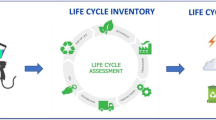Abstract
The environmental impact of three different automotive paint scenarios: (a) solventborne primer-waterborne basecoat-solventborne clearcoat, (b) powder primer-waterborne basecoat-solventborne clearcoat, and (c) powder primer-waterborne basecoat-powder clearcoat were investigated. Scenarios (a) and (b) are in production by the U.S. automotive industry and scenario (c) is a potential future goal. The scenarios modeled assume a greenfield plant, considering a mid-size sport utility vehicle that is painted in two separate colors. A complete life cycle analysis of the materials and processes was carried out using commercial state-of-the-art software. The analysis showed that a transition from solvent-based to powder-based coatings for the primer and clearcoat leads to an improvement in the environmental performance of the paint processes. The decrease in total energy consumption, water usage, and sludge generation is 22%, 34%, and 27%, respectively. The paint scenario comprised of powder primer-waterborne basecoat-powder clearcoat will minimize the environmental impacts of the painting processes for all the metrics examined in this study.
Similar content being viewed by others
References
Graedel, T.E. and Allenby, A.R.,Industrial Ecology and the Automobile, Prentice Hall, Inc., Englewood, NJ, p. 20, 1998.
Papasavva, S. and Moomaw, W., “Life-Cycle Global Warming Impact of CFCs and CFC-substitutes for Refrigeration,”J. Ind. Ecology, Vol. 1, No. 4, pp. 71–91 (1998).
Fox, J.W. and Cramer, D.R., “Hypercars: A Market-Oriented Approach to Meeting Lifecycle Environmental Goals,” Society of Automotive Engineers, paper 971096 (1997).
Measures of Environmental Performance and Ecosystem Condition, Peter Schulze (Ed.), National Academy of Engineering, National Academy Press, Washington D.C., 1999.
“Life Cycle Design Framework and Demonstration Projects. Profiles of AT&T and Allied Signal,” U.S. EPA, EPA/600/R-95/107 (1995).
“The President’s Council on Sustainable Development Eco-Efficiency Task Force,” Auto Team Report, March 1, 1996; website: www.whitehouse.gov/PCSD.
Harsch, M., Finkbeiner, M., Piwowarczyk, D., Sauer, K., and Eyerer, P., “Life-Cycle Simulation of Automotive Painting Processes,”Automotive Engineering International, pp. 211–213, February (1999).
Dobson, I.D., “Life Cycle Assessment of Painting Processes; Putting the VOC Issue in Perspective,”Prog. Org. Coat, Vol. 27, pp. 55–58 (1996).
SETAC Workshop Report, “A Technical Framework for Life Cycle Assessment,” Smugglers Notch, VT, August 18, 1990.
The Boustead Model, Version 3, www.boustead-consulting.co.uk/products.htm.
“Fan Engineering,” Robert Jorgensen (Ed.), Buffalo Forge Inc., 1970.
Personal communication with Buck McKinney at DuPont Automotive Finishes and Peter Gribble at Seibert Powder and Coatings (1998).
Sullivan, David L., U.S. Patent 3,655,795, April 11, 1972.
Welton, Donald E., U.S. Patent 3,607,948, September 21, 1971.
Davis, Darwin D., U.S. Patent 3,576,856, April 27, 1971.
Nordstrom, D.J., “Automotive Clearcoats Incorporating Silane Functionality and Auxiliary Crosslinkers,”Proc. Waterborne, High-Solids and Powder Coatings Symp., New Orleans, LA, February 22–24, 1995.
Papasavva, S., Kia, S., Claya, J., and Gunther, R., “Life Cycle Analysis of Automotive Powder Primers,”Eur. Coat. J., Vol. 1, pp. 92–95 (2001).
Papasavva, S., Kia, S., Claya, J., and Gunther, R., “Characterization of Automotive Paints: An Environmental Impact Analysis,”Prog. Org. Coat., Vol. 43, pp. 193–206 (2001).
Houghton, J.T., Filho, M., Bruce, J., Lee, H., Callander, B.A., Haites, E., Harris, N., and Maskell, K., “Climate Change 1994: Radiative Forcing of Climate Change and An Evaluation of the IPCC IS92 Emission Scenarios,” Cambridge University Press, p. 222, Cambridge, 1995.
Personal communication with Ferman, M., GM R&D, 1999.
Fischer, S.K., “Energy and Global Warming Impacts of CFC Alternative Technologies.” Sponsored by the Alternative Fluorocarbon Environmental Acceptability Study (AFEAS) and DOE, pp. 3.13 (1991).
Author information
Authors and Affiliations
Additional information
Research and Development Center, Warren, MI, 48090.
World Wide Facilities, General Motors.
Rights and permissions
About this article
Cite this article
Papasavva, S., Kia, S., Claya, J. et al. Life cycle environmental assessment of paint processes. Journal of Coatings Technology 74, 65–76 (2002). https://doi.org/10.1007/BF02720151
Issue Date:
DOI: https://doi.org/10.1007/BF02720151




